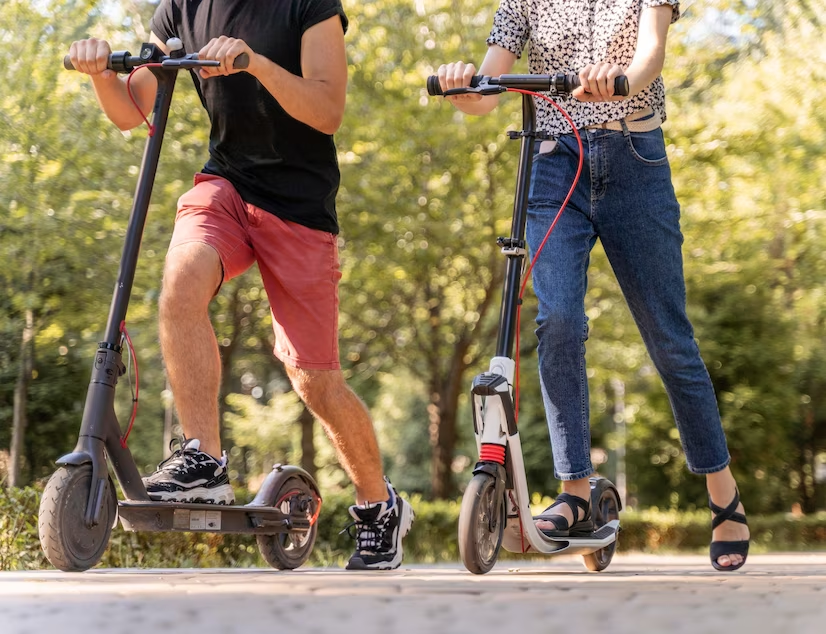
Kick Scooter VS Electric Scooter: Which One to Choose?
In this electrifying exploration, we delve into the world of kick scooters and electric scooters, uncovering the nuances that make each ride unique. Get ready to roll as we break down the differences, consider key factors, weigh the pros and cons, and even discover if your electric scooter can moonlight as a manual powerhouse! Let's hit the pavement and find your perfect ride.
What Is a Kick Scooter?
A kick scooter, also known as a push-scooter, is a human-powered street vehicle characterized by a handlebar, deck, and wheels, and is propelled by a rider pushing off the ground with their leg. These scooters are predominantly constructed from materials such as aluminum, titanium, and steel. While the most common ones feature two wheels, there are variations designed for younger children with 3 to 4 wheels, typically made of plastic and lacking a folding mechanism.
What Is an Electric Scooter?
An electric scooter has risen to prominence, surpassing the popularity of internal combustion-engined scooters since 2000. Typically featuring two wheels ranging between 8 and 11 inches in diameter, these scooters are equipped with an electric motor, either on one or both wheels. The rider stands on a platform connected to the wheels, with a handlebar for support and steering. The utilization of an electric motor eliminates the need for gears and may incorporate regenerative braking for energy recovery. The range and speed of electric scooters vary significantly between models, with reported ranges spanning from 3 to 220 km and maximum speeds ranging from 19 to 120 km/h.
Kick Scooter VS Electric Scooter: What Are the Differences?
The distinction between kick scooters and electric scooters is evident in their modes of propulsion. Electric scooters are equipped with a battery-powered motor, eliminating the need for manual effort from the rider. Users simply stand on the deck, and the device moves automatically. In contrast, kick scooters lack an electrical motor, relying entirely on the rider's physical effort. To move forward, the rider must kick their foot against the ground repeatedly. While non-motorized kick scooters demand more effort and can be tiring, they are generally more affordable. Electric scooters, with a variety of shapes and models, come at a price range of $300 to $7,000, depending on the chosen category. Kick scooters, available in only two types for kids and adults, are less expensive and offer fewer color options and additional features compared to their electric counterparts.
Kick Scooter VS Electric Scooter: What to Consider?
When deciding between a kick scooter and an electric scooter, various factors should be considered to ensure the chosen product aligns with your specific needs.
- Terrain plays a crucial role. If your intended route is smooth and flat, a manual or budget electric scooter may suffice. However, for rough surfaces or hilly terrains, mid-range or premium electric scooters with robust batteries and powerful motors are recommended.
- Consider the distance you plan to cover, manual scooters are not ideal for long distances, whereas electric scooters, with ranges exceeding 40 miles on a single charge, are better suited for extended journeys.
- Speed is a significant factor, with electric scooters generally moving faster than their manual counterparts. If speed is a priority, electric models are preferable.
- In terms of safety, electric scooters offer enhanced stability and control due to front and rear brakes, making them a safer choice.
- Price considerations also come into play, as automatic models tend to be pricier due to their advanced features.
- Portability depends on weight, with manual scooters generally being more lightweight, especially children's models. If fitness is a consideration, manual scooters provide exercise benefits through the physical effort required for propulsion.
 Kick Scooter VS Electric Scooter: Pros and Cons
Kick Scooter VS Electric Scooter: Pros and Cons
The decision between kick scooters and electric scooters depends on individual preferences and specific needs related to speed, convenience, and intended use. Here are the pros and cons of kick scooter and electric scooter:
Electric Scooter
Pros:
- High speed
- Multiple features
- Easy to control
- Tireless rides
- Safer rides with better brakes and lights
- Great range with the right model
Cons:
- Expensive
- Requires more maintenance
- Heavier
- Not as portable
- Not all models suitable for kids
Kick Scooter
Pros:
- Usually very cheap
- Kid-friendly
- No charging times
- Low maintenance
- Encourages physical fitness
Cons:
- Low speed
- Tiring rides
- Can't travel long distances
Can Electric Scooters Be Used Manually?
Yes, electric scooters can be used manually, but there are both pros and cons to consider. Pros include the potential for a small battery charge-saving with manual riding and the existence of regenerative braking systems, although the latter has limitations. On the flip side, there are notable cons. Manual riding is difficult and tiring due to the scooter's weight, leading to decreased attentiveness. Tires may wear out faster, and the lack of a neutral mode means increased resistance to manual movement. Larger wheel size and a higher deck add to the difficulty. Despite these drawbacks, most entry-level electric scooters can still be ridden manually, especially if they are comparable in size to traditional kick scooters.
Conclusion
In summary, kick scooters, relying on manual effort, offer an affordable and fitness-focused option, suitable for short distances. Electric scooters, while more expensive, provide a convenient and faster mode of transportation. The choice depends on factors like terrain, distance, speed preference, safety concerns, budget, and portability needs. Both types have their pros and cons, catering to diverse user preferences in the evolving world of urban mobility. If you want to learn more about electric scooter, come to JOYOR and consulate our experts!

